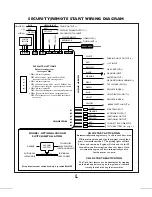
Before you begin the installation:
• Verify that the vehicle is equipped with
electronic fuel injection.
• Verify that the vehicle is equipped with an
automatic transmission.
• Check to see if the vehicle is equipped with
any type of factory security system.
• Check to see if there is a pin switch for the
hood, if not one must be installed.
• Verify that the vehicle starts and idles
properly before you start the installation.
• Verify with the customer the desired location
for the program switch and LED.
• Always use a multi-meter when verifying
vehicle wiring.
Remote Start Installation Notes:
The system senses the vehicle’s successful start
using one of the following methods:
1. Current sense
2. Tachometer sense
3. Spark or Coil Wire sense
4. Using optional vacuum switch.
If the Current Sense feature of the system does
not allow proper operation, the tachometer
sense/spark sense wire may be used, or an
optional vacuum switch can be installed.
To use the tach sense/spark sense wire, set dip
switch #4 to the
off
position. Connect the gray
wire directly to the vehicle’s tach wire or extend
it into the engine compartment and wrap it
several times around a spark plug or coil wire.
In situations were a tach wire is unavailable or
does not allow proper operation, an optional
vacuum switch can be installed. The vacuum
switch is designed to be placed in line with one of
the vehicle’s vacuum hoses and provide a ground
output (N/C) until the engine is started. To use
the vacuum switch, set dip switch #2 to the
off
position. Connect the yellow wire (3-pin red
connector) to one terminal of the vacuum switch
and connect the other terminal to ground.
High-Current Wire Connections:
• RED WIRE #1 -Main power input; using the
supplied inline fuse holder, connect directly to
the vehicle’s battery or alternate power source
with a minimum 30 Amp supply.
• RED WIRE #2 - Secondary power input; using
the supplied inline fuse holder, connect directly
to the vehicle’s battery or alternate power
source with a minimum 30 Amp supply.
Note: If not connecting directly to the vehicle’s
battery, it is recommended to use separate
power sources (minimum 30 Amp each) for each
red power wire.
• BROWN WIRE - Second ignition output;
connect to the wire that sw12V and
does not drop out during cranking.
• YELLOW WIRE - Main ignition output;
connect to the main ignition wire that switches
+12 V and does not drop out during cranking.
• ORANGE WIRE - Main accessory output;
This pr12V output to heater and/or air
conditioning system. Some cars may have more
than one accessory wire. In these vehicles add a
relay(s) to power the extra accessory wire(s).
• PURPLE WIRE - Starter output; connect to
the vehicle’s starter wire.
2






























